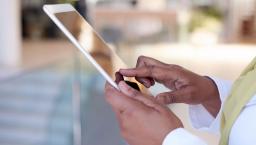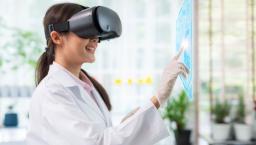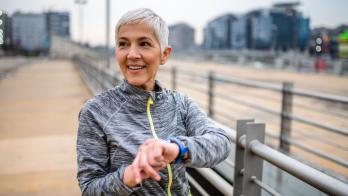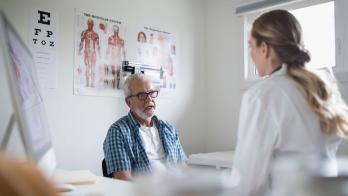.jpg)
The Internet of Things (IoT), also known as the ecosystem of connected devices that collects and transmits data from users and their environments, is impacting the world. Smart phones, laptops and any equipment in general owned by a user can help various industries understand consumer behaviors and develop better technology.
This network of devices is leaving its footprint in healthcare. In the current COVID-19 world, the interactions between patients and caregivers have become remote in many cases. This has created an increased need for intelligent medical devices that enable caregivers to diagnose and treat patients remotely.
The Internet of Medical Things (IoMT) consists of medical devices, platforms and other tools – anything from inhalers or wearable biosensors to chatbots and thermometers – with a deep impact on patients' health outcomes.
The benefits of IoMT
Smart medical and platform services allow patients to send their health data to caregivers, who can establish more accurate diagnoses based on this data, hence decreasing the risk for errors in the prevention and treatment of medical affections.
This risk is lowered due to the availability of medical history in the IoMT network, which makes the work of Healthcare Providers (HCP) more accurate and easier: An HCP can check this history in the network instead of having the patients collect data individually.
Fewer in-person visits to the doctor’s office have the potential to translate into lower medical costs and, in the current environment, lead to a potential decrease risk for infections, especially for vulnerable categories of populations affected by severe or chronic diseases. There are a number of industry examples.
Wearable biosensors
Small and lightweight, biosensors are easy to wear and enable the monitoring of vital signs like heart rate, body temperature or breathing rate. This type of wearable biosensor provides remote operation of virtual caregiving units, enabling the prevention and detection of disease symptoms, as well as the evolution of the illness.
During the COVID-19 public health emergency, the Food and Drug Administration approved medical devices to support the monitoring of hospitalized COVID-19 patients, and that could indicate signs of deterioration. One such sensor was first used at OLVG Hospital in the Netherlands where it was installed in the isolation rooms of patients suspected of COVID-19 who did not require ventilation.
The sensor, placed on the chest of the patient, collected and sent medical data such as respiratory rate and heart rate, considered the main signs of disease deterioration, every minute. Other parameters monitored by the wearable biosensor included activity levels and posture.
Wearable biosensors have also been the subject of a study that monitored (both inside and outside the care units’ settings) the patients affected by multiple sclerosis (MS). Cardiac and activity monitoring (CAM) devices have tracked important parameters, such as motion, environmental exposure, body temperature and heart rate. It could be feasible to use biosensor measurement techniques in MS monitoring.
Virtual caregiving units
Virtual caregiving units represent a concept that allows HCPs to provide remote care to patients in their homes. Medical wearables and technology enable these patients to remain in their preferred settings while reducing transportation and hospitalization costs concerns. Virtual caregiving units also enable hospitals to have more beds for patients who require in-person care.
In February 2020, Royal Prince Alfred Hospital (RPA) in Sydney had been redesigned into such a virtual caregiving unit. Patients experiencing COVID-19 symptoms have been equipped with armpit patches to track body temperature and with small devices attached to fingers called pulse oximeters that can measure heart rates and levels of oxygen saturation.
The data collected was then sent with the help of an application installed on patients’ phones to HCPs from RPA.
At the other end of the world, virtual clinics have been created in the United Arab Emirates to enable access to remote care for specialties ranging from cardiology and gynecology to pediatrics and mental health.
Created as a preventive measure to stop the spread of COVID-19, these virtual units use smart medical devices and integrated AI solutions to provide medical services without the need of face-to-face meetings between patients and doctors.
The main advantage in creating and using this type of virtual wards or “hospitals without walls” is that they can change the long-term process of caregiving. They can increase the amount of medical support provided to patients affected by chronic diseases and can also improve the percentage of people whose health is monitored on a regular basis with the help of smart medical devices and technology, no matter how far they are physically from a medical unit.
Smart thermometers + apps
Smart thermometers joined by apps can be a valuable help especially for parents whose children experience fever alongside other symptoms. The data collected by smart thermometers is used to check for signs indicating the outbreak of a disease, while the corresponding apps provide parents of small children insights on treatment based on indicators such as the child’s age and various symptoms.
The data is shared with the family doctor or with the pediatrician, who can provide additional recommendations for treatment and use this data for maintaining the medical history of patients.
Artificial pancreas systems
Also known as closed-loop insulin delivery systems or automated insulin delivery (AID) systems, these devices represent a major breakthrough for the 8.5% adults affected worldwide by diabetes.
The operating principle is simple:
- Continuous glucose monitors (CGMs) monitor blood sugar levels at night and determine the necessary amount of insulin.
- The required amount is inserted into the body with the help of an insulin pump and is adjusted, depending on the modification of the sugar levels in the bloodstream.
AID systems used in combination with CGMs improve the comfort of people suffering from diabetes. They are no longer required to constantly measure their glucose levels in the blood with finger blood tests. Most importantly, the systems decrease the severe and sometimes frequent oscillations between highs and lows of glucose levels in the blood.
Currently run by a handheld device called a receiver, people suffering from diabetes expect the development of AID systems that can be managed remotely with the help of an application. That expectation that could turn into reality this year.
By decreasing the number of oscillations between highs and lows of glucose levels in the blood, AID systems can prevent severe health issues for patients suffering from diabetes, improve the life and comfort of those affected by this disease, and lead to cost savings for the healthcare system when the number of specialized health interventions is lower.
Chatbots
The increase of digital interactions between patients and caregivers has translated in many cases into automation of areas that support digital tools implementation.
AI-powered chatbots can conduct a wide range of assistive medical tasks such as providing recommendations to treatments, assessing symptoms or scheduling physical visits to the doctor’s office. Some chatbots are designed to exchange text or instant messages with patients about their symptoms and provide correspondent advice on how to proceed.
Others can acknowledge the changes in conversation partners’ moods and adjust their answers accordingly, in order to help people navigate through difficult times and offer mental health support. The Centers for Disease Control and Prevention hosts an AI-powered chatbot that can assist patients in screening COVID-19.
AI-powered chatbots have already proven an efficient solution for remote interactions in healthcare, especially during these pandemic times.
Care for aging patients
The pandemic's social distancing measures made it difficult for relatives and caretakers to visit and take care of elders on a regular basis. Social distancing measures also increased aging adults’ sense of isolation.
Specially designed pendants worn by senior patients can detect domestic accidents such as a fall. Some remote monitoring devices can be inter-connected with others such as smart thermometers or blood pressure monitors. Together they provide a complete image of changes in patients’ health.
Other RPM devices are designed to learn a patient’s habits and movements and to inform the correspondent caregiver if the patient does not show any movement or modified movement pattern for an unusual period of time.
Such devices can be tailored according to a user’s privacy preferences, such as using audio-only instead of video functions. Another option includes smart devices that serve as reminders to ensure patients take their proper medication at the right time, or devices that enable users to call their close ones with just their voice.
Smart inhalers
According to the Royal College of Physicians, two in three deaths caused by asthma could be prevented if more suited medications would be prescribed to patients, if customized treatment plans would be assigned and followed accordingly, and if the care provided would be reviewed on a regular basis.
Because asthma and other respiratory conditions cannot be effectively treated without proper monitoring, one solution to this problem – smart inhalers – is being recommended to more patients for tracking purposes. Accompanied by applications installed on patients’ phones, these inhalers monitor the medication plans and provide alerts – visual, audio or both – to remind patients when it’s time to take their medication and what dose they should take.
These smart inhalers can also instruct patients on how to optimize their inhaling techniques and how to stick to their medication plan. Based on data collected, the devices send reports to the patients’ physicians, who can decide to change or to adjust the medication or the treatment prescribed.
Research projects aim to provide support in the area of respiratory condition prevention by monitoring the gases or pollen in the patient’s environment. Such medical devices could quantify the factors that trigger asthma attacks, especially for patients vulnerable to COVID-19 infection.
Worn on a permanent basis and joined by smart sensors such as environmental monitors, smart inhalers could have a significant impact on preventing asthma episodes.
Conclusion
The IoMT is already shaping healthcare with significant benefits for patients, clinicians, providers and payers. The emergence of new and additional technologies in IoMT will provide increased and improved remote access to medical care for users all around the world. Benefits will be further realized through consideration of both access to connectivity and security for these devices.
 About the Author
About the Author
Dr. Liz Kwo a serial healthcare entrepreneur, physician and Harvard Medical School faculty lecturer. She received an MD from Harvard Medical School, an MBA from Harvard Business School and an MPH from the Harvard T.H. Chan School of Public Health.











def4.jpg)








